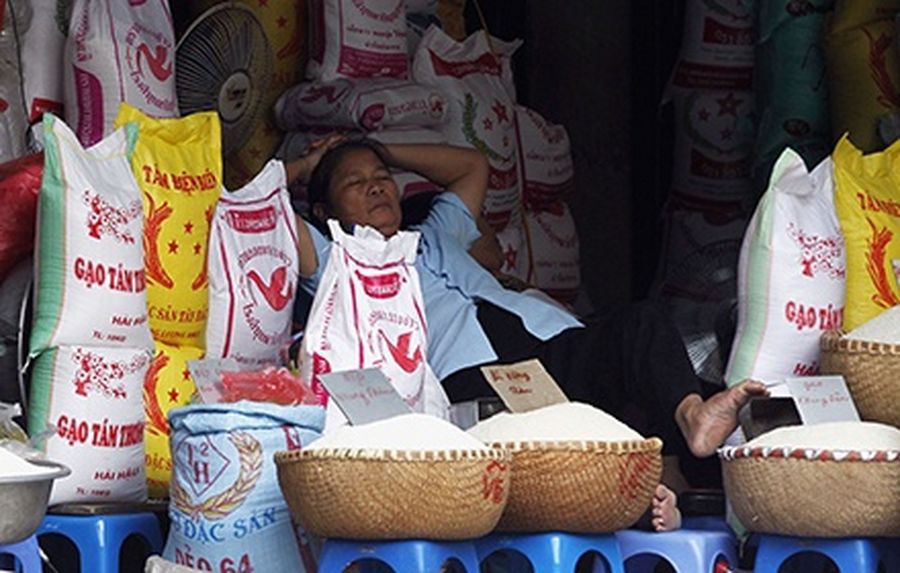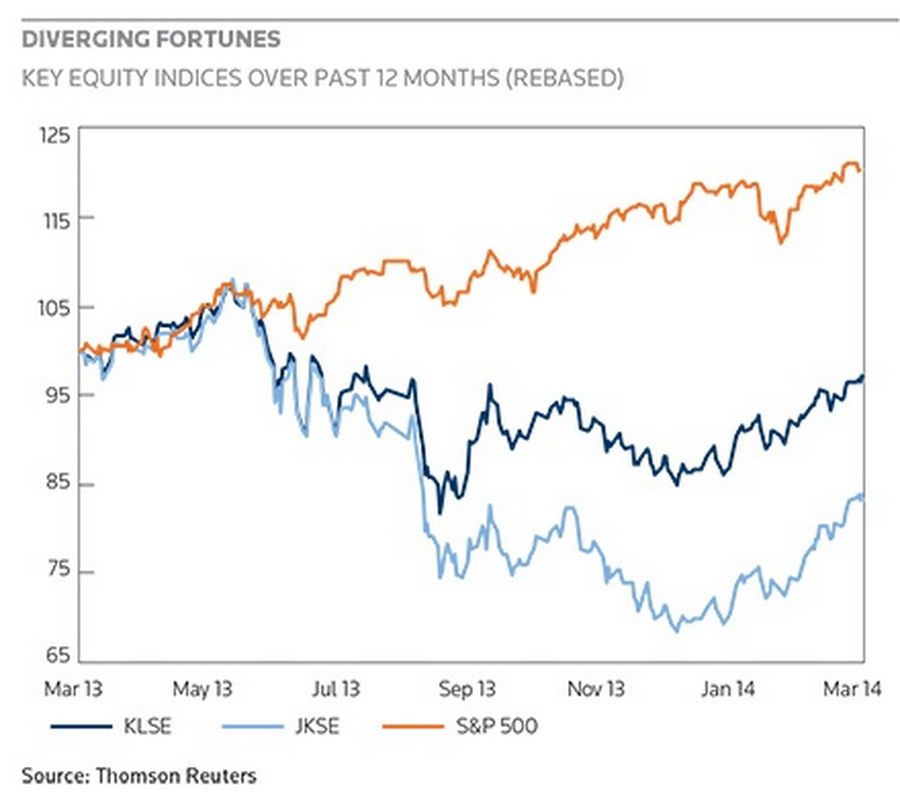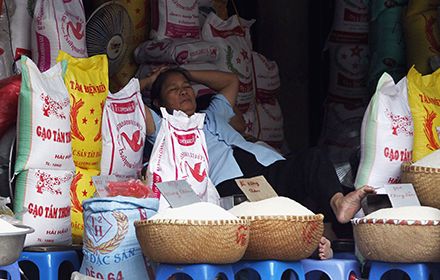South-East Asia’s equity markets are rebounding and the region’s economies continue to grow strongly, but investors remain wary and new listings, largely as a result, are sparse.

Percolating slowly
Source: REUTERS/Kham
A rice seller takes a rest as she waits for customers at a market in Hanoi.
International investors have shied away from South-East Asian stock markets as returns plummet, but, amid good prospects for economic growth throughout the region, investors may soon find buying opportunities.
“South-East Asia continues to be viewed as solid because of the core thematics of strong population and GDP growth, and stable balances,” said Stuart Mackay, head of equity capital markets (South-East Asia), at UBS.
As a result, the outflow of funds from the region had moderated and, in some cases, reversed, he pointed out.
There is no doubt 2013 was a bad year. The US Federal Reserve’s announcement in May that it would begin scaling back its massive monetary stimulus was among factors that pushed Indonesia’s stock market down 25%, Thailand’s down 15%, and the Philippines’s down 10%, all on a currency-adjusted basis, according to bankers.
The sharp declines, however, has now made these markets appealing, bankers said.
South-East Asia “is again attractive, on a valuations basis, as it has underperformed relative to regional peers in the last six months”, said Edward Lee, Deutsche Bank’s head of South-East Asia ECM.
“Indeed, over recent weeks, we have seen a significant improvement in secondary fund flows, which is likely to presage an active issuance calendar for the balance of the year,” Lee said.

Percolating slowly
Most South-East Asian markets have already recovered some of these losses, with the Philippine benchmark index up 10% this year through March 7. Indonesia’s market is up 9.6% and Thailand’s is up 4.3%. The Malaysia and Singapore indices, however, are down 1.9% and 1%, respectively, year to date.
Lean pipeline
Meanwhile, the pipeline of new equity offerings throughout the region remains slim. The story was quite different last year. From January through April 2013, before the Fed declared its intention to taper its bond buying, markets in Indonesia, the Philippines, Singapore and Thailand each saw US$1bn, or close to that, in new listings.
This year, few have come forward. OUE Commercial Trust’s S$346m (US$272m) REIT offering in Singapore was the largest this year. There have been no IPOs in Malaysia and Philippines. In Thailand, PCS Machine Group Holding’s IPO raised Bt3.3bn (US$103m), while, in Indonesia, an IPO of Rp961bn–Rp1.3trn (US$83m–$111m) for Wijaya Karya Beton has been launched.
The placement-cum-block market also remains patchy with only a few interesting transactions out of Malaysia, including CIMB’s M$3.55bn (U$1bn) deal and Malaysia Airports’ M$980m offer. The one block trade in the Philippines, Bloomberry Resorts’ Ps7.6bn, was cancelled following opposition from a major shareholder.
Bankers attribute the lack of offerings to various reasons, including political strife in Thailand, stretched valuations in the Philippines, impending elections in Indonesia and the reluctance of investors to buy interest-rate linked instruments in Singapore.
Still, they are optimistic it is matter of time before deals start materialising. Renewed investor appetite is likely to be one of the triggers.
“I expect global funds to re-weight on South-East Asia at some point, possibly late in the first half, when broader emerging-market concerns and outflows are reduced and country-specific political and economic uncertainties are resolved,” said Jason Cox, co- head of APAC Global Capital Markets, at Bank of America Merrill Lynch.
“This will also support the new issue market,” Cox added.
The first batch of issuers is expected to come from retail, healthcare and consumer sectors because activities in the metals and mining, and plantation sectors remain subdued.
Even if IPO activity picks ups, volume is unlikely to match that of last year and most deals are likely to be small, in the range of US$100m to US$500m.
“Sectors related to local Asian demand will see more interest from investors,” said Vineet Mishra, head of South-East Asia ECM, at JP Morgan.
“These will include sectors like telecom bandwidth, logistics, retailing and ecommerce,” Mishra added.
Optimism in Malaysia
A bulk of the pipeline throughout the region appears to be building in Malaysia. 1MDB’s IPO of up to US$2bn, if it happens in 2014, is expected to refocus global investor interest on Malaysia the way agri-business company Felda Global Venture’s float of US$3bn did in 2012. Among other 2014 IPO candidates are 7-Eleven Malaysia, Boustead Plantations, Icon Offshore and Naza TTDI.
State-owned oil company Petroliam Nasional’s capital-expenditure programme, meanwhile, promises to lead to growth in the offshore services sector and possibly trigger equity issuances.
“Malaysia is the market to watch,” said Manish Chhalani, head of ECM, South-East Asia, at Credit Suisse.
“Domestic liquidity remains strong, while global investors are attracted to its low beta and demographics,” Chhalani said. “After the relatively quiet period in 2013 due to elections, I expect issuances of significant size in 2014, led by the energy sector.”
Indonesia, which has recovered smartly from a selloff in the second half of 2013, is also expected to have a healthy IPO pipeline once parliamentary and presidential elections are out of the way in early July.
For now Indoritel Makmur, with interests in food and retailing, plans to launch its re-IPO of US$150–$200m in the first half. Taxi operator Blue Bird, which shelved its IPO of up to US$300m last year, is expected to have another try this year, subject to regulatory approval.
Losing appeal
Singapore, which has traditionally been a listing hub for real-estate investment trusts and business trusts, is losing some of its attraction amid rising interest rates, but bankers are still trying to attract other industry players. (see Monetising Assets, Page 14.)
Tay Toh Sin, head of corporate finance at OCBC Bank, expects more offshore support services and oil exploration companies to list on the Singapore Exchange.
“Overall, the number of issues in 2014 may not be fewer than 2013, but the sizes may be smaller,” she said. “We will see IPOs in the sub-S$1bn level.”
Bankers said plain vanilla REITs and business trusts will be harder to sell as investors were not just looking for yield, but also for growth. In this context, the S$500m REIT IPO of Keppel Data Centre Trust will be crucial, as it will be the first related to a data centre trust in Asia.
In the offshore sector PACC Offshore Services Holdings started premarketing an IPO of up to US$400m in late February. About half a dozen Indian business trusts have announced plans to list on the Singapore Exchange and some of these could materialise if the outcome of the general elections in India is perceived as pro-growth.
The Philippines, which had one of the most active primary markets in South-East Asia in 2013, is off to a slow start as investors find fewer investment options in the relatively expensive and less liquid market. However, IPOs are seen picking up as conglomerates continue to restructure their companies.
“The Philippines remains most sensitive to any global inflows/outflows, given the relatively low liquidity in the market,” said Chhalani. “Smaller amounts of money can cause aggressive moves.”
Investors should look for offerings from gaming and tourism companies, Chhalani said.
For instance, courier and remittance company LBC Corp is planning a Ps6.1bn (US$137m) IPO, while a casino company is expected to launched a float for an undisclosed amount in the third quarter.
Thailand, which has the bleakest IPO visibility in South-East Asia, is expected to become an active market if the domestic political crisis is resolved. The secondary market remains relatively calm amid ongoing protests to oust Prime Minister Yingluck Shinawatra.
“There are no new fund inflows to Thailand, but, at the same time, the outflows haven’t been as serious as expected,” an ECM banker said.
Jasmine International’s infrastructure fund IPO of up to Bt50bn–Bt70bn (US$1.5bn–$2.2bn) is expected to be one of the major floats in Thailand.
The investor base is changing in South-East Asia, as international investors remain wary about investing in all emerging markets, particularly as growth picks up in the US and elsewhere.
“The focus will be more on high net-worth individuals, family offices, corporate investors as these are not so much subject to market volatility and benchmarks,” said Tay at OCBC.
One example is Summit SPV, which Chinese businessman Tong Jinquan owns. It has become a significant cornerstone investor in Singapore REIT IPOs, including those of OUE Commercial and Viva Industrial Trust. Others, such as Singapore’s Keppel Corp and Malaysia’s Genting, have invested in domestic oil-and-gas IPOs.
In the Philippines, pension and insurance funds are committing larger portions of their funds to equities and the same applies to Indonesia.
While global investor attention has of late turned to North America and North Asia, South-East Asia remains a “must invest” place for global and regional investors, particularly when the price is right.
To see the digital version of this report, please click here.
| STILL CATCHING UP | ||
|---|---|---|
| IPOS IN SOUTH EAST ASIA (Year to date) | ||
| COUNTRY | 2014 (Year to date) | January-April 2013 |
| Indonesia | Wijaya Karya Beton Rp1.3trn | Matahari Department Rp13trn |
| MPM Motor Rp1.46trn | ||
| Dharma Satya Nusantara Rp509bn | ||
| Austindo Nusantara Jaya Rp396bn | ||
| Malaysia | None so far | Tune Ins M$284m |
| Cliq Energy M$364m | ||
| Philippines | None so far | LT Group Ps38bn |
| Melco Crown Ps14bn | ||
| Philippine Business Bank Ps3.19bn | ||
| Asia United Bank Ps7.6bn | ||
| Singapore | OUE Commercial S$346m | Mapletree China Trust S$1.7bn |
| Croesus Retail Trust S$393m | ||
| Thailand | PCS Machine Group Bt3.3bn | BTS Growth Infrastructure Fund Bt42bn |

